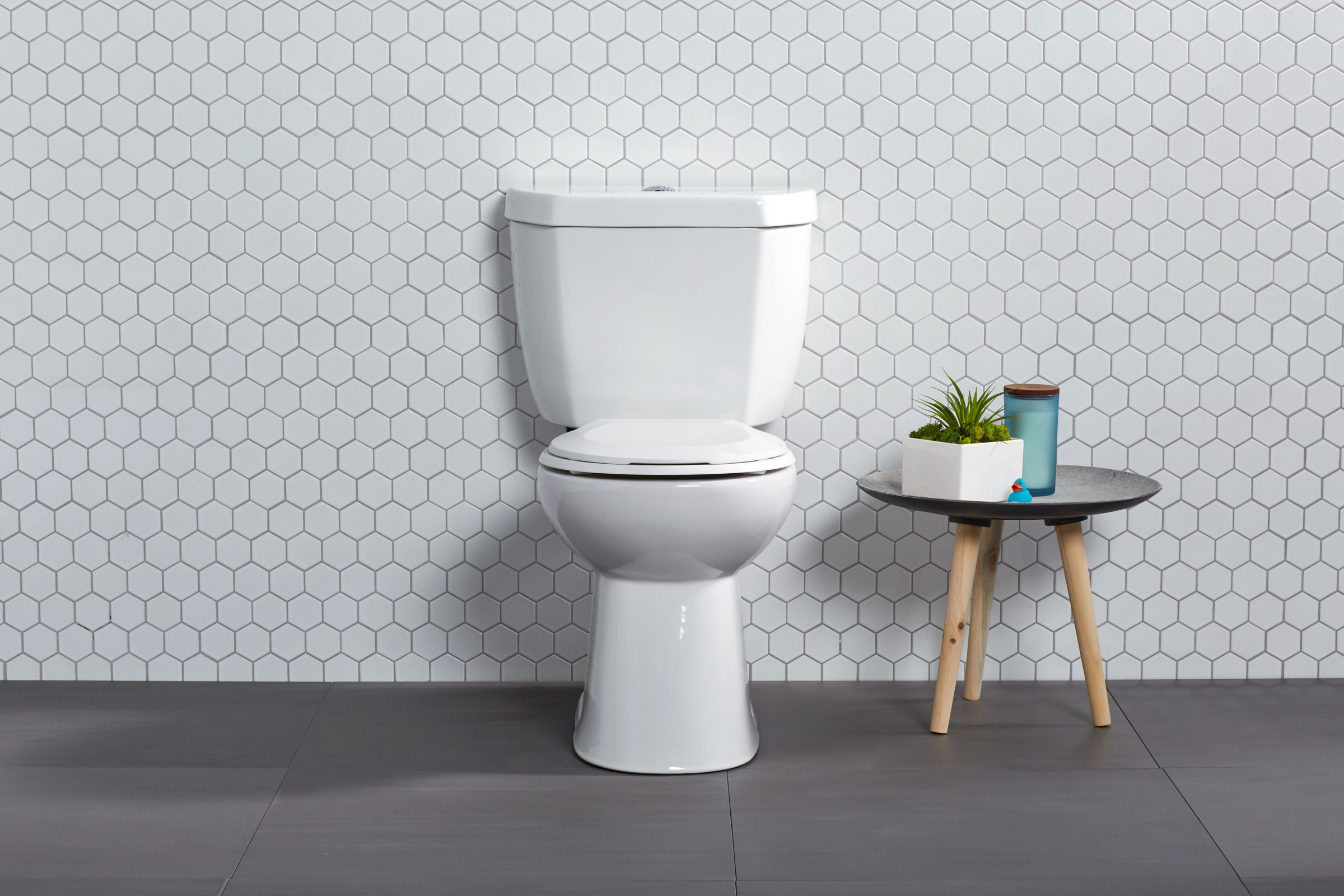Story at a glance:
- An estimated 70% of all counties in the US may face water shortages by 2050, according to the NRDC.
- The average American uses around 88 gallons per day per person or 10,500 gallons a month for a family of four.
- One of the biggest decisions you’ll have to make regarding plumbing is choosing the right toilet for the property.
According to US Drought Monitor, recent reports concerning the Colorado River, and many others, moderate to the severe drought currently affects roughly 44% of the US and Puerto Rico. Additionally, the Natural Resources Defense Council (NRDC) suggests 70% of all counties in the US may face water shortages by 2050, and at least 40 state water managers noted that they expect some water shortages in the next decade.
Unfortunately, just 3% of the world’s water is freshwater and, of that, 30.1% is groundwater and 68.7% is locked up in melting ice caps and glaciers. Much of the freshwater that is left is unusable in some manner or other, and thus only 1% of all the world’s water is fit for human consumption without treatment.
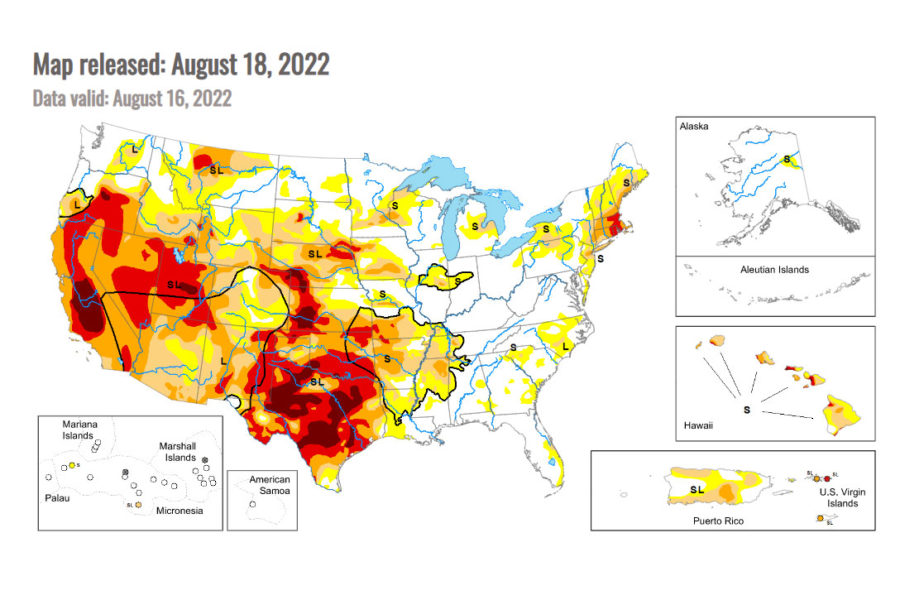
US drought monitor map. Image courtesy of Niagara
EPA surveys indicate that most Americans seriously underestimate how much water they use each day. They are also usually surprised to find out, as shown by the adjacent graph, toilets and their leaks can use about 30% of household water, and showers and taps can use another 40%.
According to the EPA the average American uses around 88 gallons per day per person or 10,500 gallons a month for a family of four. Usage and cost vary a great deal across the country, mostly because of differences in weather patterns, water availability, and the cost of water acquisition and processing. For example, water use tends to be higher in drier areas of the country, especially those that rely more on irrigation for outdoor watering.
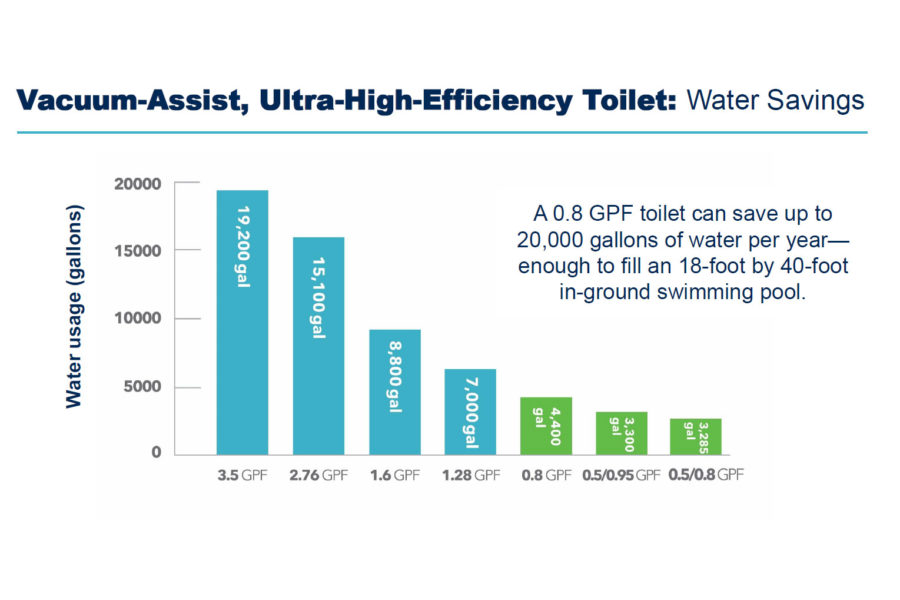
A closer look at water savings by toilet. Image courtesy of Niagara
Following the enactment of the Energy Policy Act (EPAct) in 1994, new toilets manufactured in the US could not exceed 1.6 gallons per flush (GPF), faucets could not exceed 2.5 gallons per minute (GPM), and showerheads could not supply more than 2.5 GPM. Before that toilets used as much as 7 GPF. The current baseline for an efficient toilet is considered to be 1.28 GPF; however, some toilets flush even more efficiently than this baseline.
The affordability of water and wastewater services in 12 US cities report noted that the combined price of water and sewerage increased by an average of 80% between 2010 and 2018, with more than 40% of residents living in neighborhoods with excessive bills. And as we noted in our last article when we discussed how to utilize water conservation in your sustainability planning, the 2021 US Municipal Water & Wastewater Utility Rate Index showed that the combined water and wastewater bill has increased by 43.2% since 2012.
Simultaneously, federal aid to public water utilities has plummeted while maintenance, environmental and health threats, and so forth continue to escalate. This tells us that, in addition to the lowering of demands, water and sewerage costs must be addressed in another fashion, such as financial incentives.
For example, 27 states and Washington, D.C. require affordable housing developments receiving public funds to comply with their GCC. The institution has also partnered with the WELL Building Institute to ensure developers who meet the GCC will receive WELL certification.
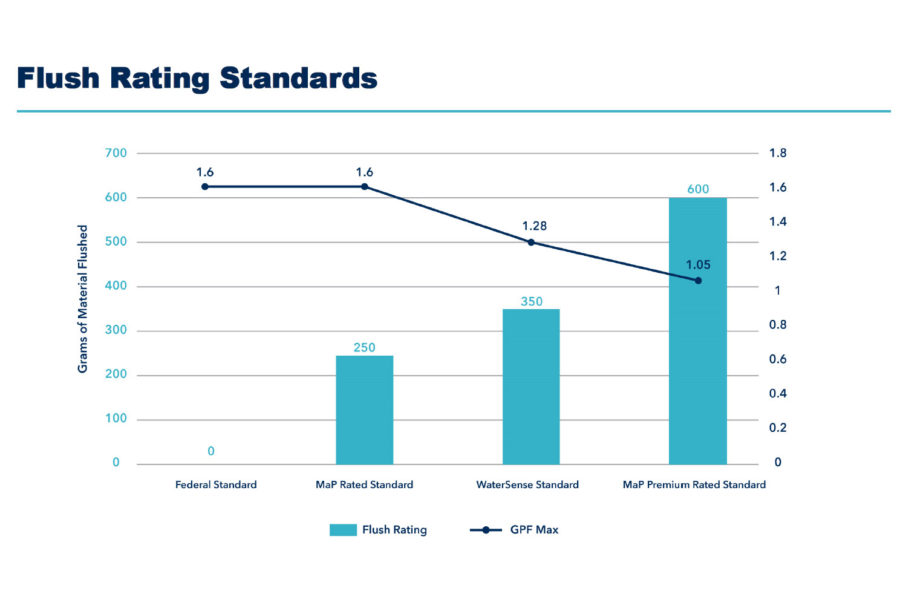
Flush rating standards. Image courtesy of Niagara
Additionally, green building practices and using environmentally friendly features like energy- and water-efficient fixtures have the potential to improve a large portion of affordable housing by accessing these credits, reducing operating costs, promoting resident health, and mitigating negative environmental impacts.
It should not be a surprise that green strategies frequently integrate energy and water efficiency. A 2017 report called “State Strategies to Increase Energy and Water Efficiency in Low Income Housing Tax Credit Properties” by the National Housing Trust and the NRDC lists several strategies in this regard.
Various existing green building standards require builders and developers to adhere to WaterSense standards at a minimum, but some offer additional incentives for utilizing greater efficiency in building products. Each green building standard allows for a higher rating when more efficient building products are installed. These standards have also demonstrated the potential financial savings attributable to green practices. LEED, the most widely used system in the world, notes that between 2015 and 2018 buildings certified saved $1.2 billion in energy, $149.5 million in water, $715 million in maintenance, and $44.2 million in waste.
Other incentives for using sustainable building materials come in the form of rebate programs for consumers and builders. Many localities, depending on region and water scarcity, offer rebates when ultra-high-efficiency products are utilized. In addition, there are several other green building assessment protocols, including the ICC National Green Building Standard, Green Globes, net zero buildings, and the Living Building Challenge, to name a few.
But to be green you have to specify green, and an immense variety of plumbing fixtures are available on the market. This can make it hard to decide which products are right for your next job. Here are a few notes to help identify the right products to specify in your next project:
Toilets
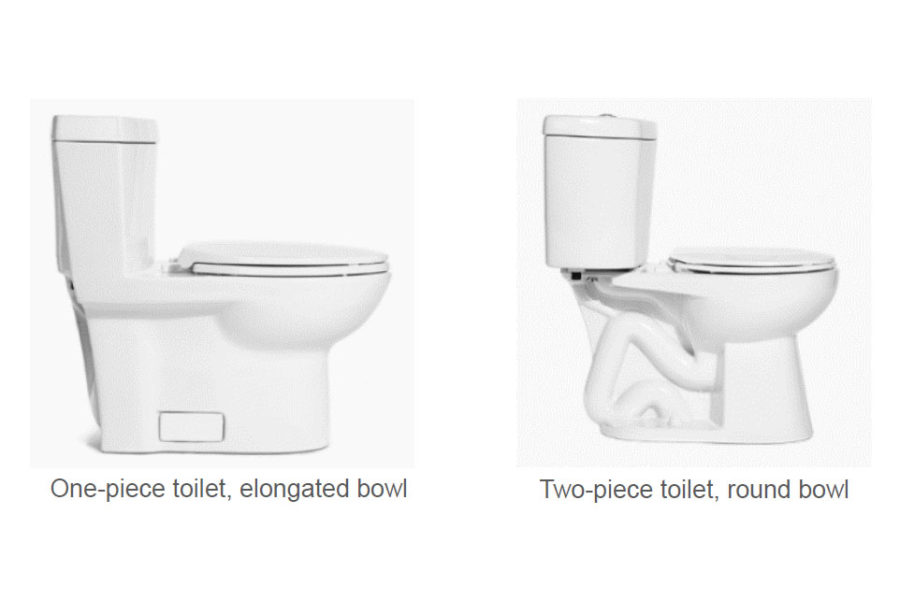
Visual representation of round versus elongated bowls. Image courtesy of Niagara
One of the biggest decisions you’ll have to make regarding the plumbing is choosing the right toilet for the property. Here are a few quick basics to consider.
Bowl Shape
• Round bowls offer a traditional appearance and use less space. This bowl shape is ideal in smaller areas where doors or cabinet doors may swing and hit the toilet.
• An elongated bowl provides an additional two inches of bowl length. This is typically the preferred bowl shape due to the added comfort it provides. If you are replacing a round bowl with an elongated bowl, be sure to carefully measure the space to avoid bumping up against doors and cabinets and to also be sure it will meet code standards.
• The best of both worlds is the compact elongated bowl. This shape features the comfortable elongated bowl style but has been modified to meet the space constraints of a round bowl. Compact elongated bowls provide a versatile option for when a toilet needs to fit in a smaller space.
Gallons Per Flush
Gallons Per Flush, or GPF, is a measurement of how much water is used each time the toilet is flushed. Thanks to decades of innovation, the ultra-high-efficiency toilets on the market today are some of the best-performing toilets available.
Technology Type
Traditional Gravity-Fed Technology
When opening the lid of a toilet’s tank, you will likely find a gravity-fed technology system. Most commonly you will come across a toilet that utilizes a flapper.
A Flapper Toilet
When a flapper toilet is flushed a rubber flapper is lifted, allowing gravity to force fresh water from the tank into the bowl, pushing waste down the trapway and into the drain system. A fill valve then refills the tank for the next use. This technology, while common, does present several maintenance headaches:
• The chain attached to the flush lever can become tangled or weakened, preventing flushing entirely.
• The rubber flapper can deteriorate or become unseated over time, creating a leak that causes the fill valve to continuously feed water into the tank.
• The fill valve can become misaligned or worn, causing the tank to not refill.
The challenges of maintaining a traditional gravity-fed toilet throughout its projected 15-year lifetime have made many plumbing professionals look into other toilet technology options that offer more consistent performances as well as a flush that uses less water.
Pressure-Assisted Technology
As the name implies, pressure-assist toilets use highly pressurized air to evacuate the bowl and push waste through the trap. These toilets use a specialized chamber within the tank that is used to create the air pressure.
Toilets equipped with pressure assist technology are highly efficient at clearing away waste and preventing clogs, which is vital for commercial and industrial applications that need a clean, unclogged toilet for each use, as downtime or an unsightly appearance can impact the overall satisfaction of a customer or employee’s experience.
These toilets also feature a larger water spot, ensuring no waste buildup is on the side of the toilet bowl. Pressure-assist toilets can find as a back outlet install type, as opposed to floor mounted. Pressure-assist toilets are louder than other toilet technology types due to the forced air used to evacuate the bowl. These models are also typically more expensive than other options because of the cost of the pressure-assist vessels in the thanks. Because of this they are rarely found in residential or other low-traffic applications.
Vacuum-Assist
Many jobs or projects need to balance both power with water efficiency when it comes to toilets. Vacuum-assist toilets provide both.
Upon flushing, the water exiting the specialized chamber within the tank creates a vacuum, depressurizing the trapway and allowing waste to be pulled through the trap. This allows vacuum-assist toilets to use substantially less water. Many vacuum-assist toilets meet EPA’s stringent WaterSense certification requirements as well as achieve a MaP Premium certification—highlighting the efficiency as well as the power of these toilets. Some models even use as little as 0.8 GPF, offering maximum water savings.
Vacuum-assist toilets are becoming more favored in a variety of applications for several reasons. The chamber within the tank eliminates the moving parts found in traditional toilets, significantly reducing required maintenance from worn-out or unseated components. Plus, the fill valve remains submerged, reducing the noise heard during refill and creating a whisper-quiet flush. But the powerful, quiet flush paired with efficient water use is typically the main decision driver. With no change in customer use, a powerful flush is achieved while reducing the amount of water used, creating remarkable cost savings throughout the life of the toilet.
Other Things to Consider
Drain Line Carry
Drain line carry refers to the distance that a toilet can move waste down the drain line. A toilet with poor line carry will cause plugs in the line. Under ASME A112.19.2, a toilet must move waste down a drain line of at least 40 feet. Testing is done by third parties like the IAPMO to ensure results are unbiased and accurate.
Certifications
WaterSense
The EPA WaterSense Program mandates water usage of plumbing fixtures to drive innovation, conservation, and elimination of waste. Designed for companies and consumers who are committed to conserving water, a separate EPA certification process is required to earn the WaterSense label. For a toilet to be WaterSense certified, it must flush at or under 1.28 GPF and pass a rigorous round of performance tests.
MaP and MaP Premium
The measurement of water efficiency in toilets goes beyond GPF. Look for toilets that carry the MaP Premium label. Maximum Performance is an independent testing program that evaluates toilet water use beyond even the top EPA standards, testing both the volume of water used per flush as well as grams of solid waste cleared per flush. For a toilet to be MaP Premium certified it must flush at or under 1.1 GPF and clear at least 600g of miso or waste.
Warranty
A toilet that is backed by a robust warranty provides peace of mind for both professionals and the end customer. Be sure to evaluate the warranties of toilets you consider.
Choosing an Aerator
Invented by a Greek engineer named Elie Aghnides, the faucet aerator came to the market in 1943. An aerator is a small device that screws onto the tip of a bathroom or kitchen faucet. When asked, Aghnides said he got the idea from watching a waterfall.
Using faucet aerators may help meet local regulations and construction standards, including ASME A112.18.1 and LEED, but most importantly aerators help save water and money.
According to the EPA, WaterSense labeled bathroom sink faucets and accessories that use a maximum of 1.5 gallons per minute can reduce a sink’s water flow by 30% or more from the standard flow of 2.2 gallons per minute without sacrificing performance. Aerators also help to improve energy usage by reducing the level of hot water consumption as well. By reducing the amount of hot water being used, the water heater is used less frequently, saving both energy and money.
Replacing old, inefficient bathroom faucets and aerators with WaterSense labeled models can save the average family nearly 11,000 gallons of water over the faucets’ lifetime.
Showerheads
For those of you who need to supply a full bathroom set, showerheads can play a big part in client satisfaction. Invented in the 18th century, showerheads are a standard fixture in every residential space as well as some commercial spaces. There are 12 main types of showerheads: standard fixed, handheld, dual, filtered, waterfall (rain), massage, high-pressure, low flow, shower panels, LED, RV, and Navy shower heads.
Low-Flow and WaterSense Showerheads
Showers account for 17% of residential indoor water use, according to the EPA. To be WaterSense-certified, showerheads must demonstrate that they use no more than 2.0 GPM (gallons per minute). By switching from a non-WaterSense certified showerhead to one that has it, a family could save 2,700 gallons a year and more than 330-kilowatt hours of electricity annually which is enough to power a house for 11 days.
Because the initial introduction of “low-flow” models to the market did not have criteria for measuring performance, the EPA along with the ASME/CSA Joint Harmonization Task Group developed criteria and tests to put showerheads through before they could be WaterSense certified. For a showerhead to earn a WaterSense label, it has to:
1. Show that the showerhead has sufficient spray force, or pressure, to provide user satisfaction.
2. It needs to meet a spray coverage test proving it’s not too narrow or too wide.
3. It has to ensure that the showerhead will provide for a minimum flow across a range of household water pressures.
Luckily all three varieties of showerheads mentioned earlier are available in models that are WaterSense-certified, which means they have to perform just as well as their non-certified counterparts.
Selecting the Best Products for Your Projects

The Branch Village Townhomes in Camden, New Jersey use Niagara toilets. Photo courtesy of Urban Practice
It’s important to keep the application in mind when choosing a product. With such a wide range of plumbing products available, you want to ensure the products selected will meet your specification needs as well as those of the end user.
Multifamily
Multi-family housing presents a unique set of challenges when selecting products due to the sizes of the buildings, both in terms of square footage as well as the number of toilets, plus a frequent rotation of tenants that may have differing needs.
High efficiency is a must in multi-family. Inefficient plumbing products will lead to higher water usage (and higher utility costs), while leaks from poor-quality toilets will silently create higher costs as well. Many building owners look to modern plumbing fixtures like faucet aerators and fixed showerheads to quickly cut costs and boost their asset value.
Due to the geographical footprint of multi-family properties, drain line carry is of vital importance. Toilets situated on higher floors will need sufficient force to push waste to the sewer lines at ground level.
A busy maintenance staff leads to higher costs and frustrated tenants. A low-maintenance toilet will alleviate maintenance headaches and ensure tenants aren’t struggling with inoperable toilets.
Recommended products: Vacuum-assist toilets provide a quiet flush, plus save the customer money with less water used each flush. The vacuum-assist chamber also eliminates common toilet maintenance headaches. Fixed showerheads are perfect for a space where many different individuals may have different needs, and aerators are a necessity for water and electricity savings.
Residential
A homeowner likely has two main goals when a new toilet is being installed—reliability and efficiency. A toilet can be used for more than 20 years, so it is vital to make a great long-term selection.
Key factors homeowners consider when choosing a toilet are:
Flush Technology Type
A vacuum assist toilet will require less maintenance, use less water, and has virtually no noise when flushed.
One-Piece or Two-Piece
Some homeowners may prefer the sleek look of a one-piece toilet, which also provides smoother surfaces for easier cleaning.
Water Efficiency
Don’t underestimate the cost savings of a high-efficiency toilet. The savings from a high-efficiency toilet on its own can be notable, but combined with updated showerheads and faucet aerators, the utility savings could be saving hundreds or thousands of dollars annually.
Recommended products: Vacuum-assist toilets provide a quiet flush, plus save the customer money with less water used each flush. Traditional toilets are also a great use here since there is only one family in the home. For showerheads, we recommend letting the homeowner decide due to preference, and faucet aerators on the bathroom and kitchen faucets are a great addition for extra water and electricity savings.
Light Commercial
Businesses like gyms, offices, retail spaces, and doctor’s offices have different goals when it comes to selecting plumbing products. Heavy foot traffic means the restrooms are frequently in use. An unkempt restroom leaves a negative impression on customers so the toilet must remain clean after each use. Factors like limited space and noise reduction are often not as large of a concern compared to residential applications.
Clogs and line plugs can be costly in light commercial spaces, especially in smaller buildings such as doctor’s offices that may not have many additional restrooms. A fully functioning and clean restroom is part of the excellent customer service experience every business strives for; it’s important to not overlook the role a toilet plays in that experience.
Showerheads are not as important as aerators in these spaces. An aerator can make sure water is not splashing from the bowl and onto a user who may not want a wet shirt, and it can help bring the cost of utilities down for the property managers.
Recommended products: A pressure-assist toilet is the preferred choice for light commercial spaces. The high-power flush ensures a completely evacuated bowl after each flush, while features such as rim jets provide a finishing touch that leaves the toilet bowl clean. Showerheads are going to need to be up to the property owner’s discretion, but aerators are a necessity for user satisfaction and utility savings.
Use these tips to find products that work best for your next round of specifications, and if you’d like to speak to a water-conservation expert, you can always reach out to Niagara’s team of experts who would be happy to discuss water-saving products that will benefit your firm.

